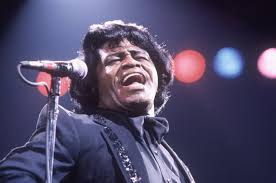It’s time to catch PBS’ favorite kind of music. Which, of course, is classical.
Or maybe it’s funk (shown here with James Brown) Or country or Latin. Or blues or ballads or bluegrass or Broadway.
All of that shows up soon on PBS, which is also the birthplace of “Rubber Ducky” and “Won’t You Be My Neighbor?”
There are times (usually federal-budget times) when people peg PBS into one category. In truth, it strains to be everything – from kids to antique, from dramas to nature. And it’s music tastes reflect those extremes.
There have been two film biographies — on radiant cellist Jacqueline du Pre (March 28) and Broadway’s Liza Minnelli (April 1). Coming up: A wide-ranging “Austin City Limits” special (April 4), “We Want the Funk” (April 8), Chopin (April 11) and more, including jazz and Broadway musicals. Let’s look at some upcoming ones:
— “AUSTIN CITY LIMITS” (9-11 p.m. Friday, April 4).
The notion was basic: Austin, Texas, had an emerging music scene, variously described as “redneck rockers” or “country gone awry.” Its PBS station taped two pilots for a concert series.
The first, with B.W. Stevenson, sputtered because enough people weren’t invited for the audience. The second – Oct. 17, 1974 – had Willie Nelson, then (at 41) an acclaimed songwriter and semi-known singer.
This was not like stagnant shows elsewhere. “The people who worked on the show loved music,” Lyle Lovett wrote in “Austin City Limits: 25 Years of American Music” (Billboard Books, 2000). “Some of them were were musicians themselves. (It) was a thoughtful, honest presentation of singers, songwriters and musicians.”
Musicians were free to vary, as they might in any concert.
“Sidemen were liberated to play as they knew how to play,” Bill Arhos, the show’s co-founder and producer, wrote. “It didn’t matter what their discipline was. It was blues, bluegrass, country and more.”
And then much more. In those early years, the show had such varied people as Ray Charles, Jerry Lee Lewis, B.B. King, Roy Orbison and Garth Brooks.
Later years added to that. The 50-year special has brief glimpses of people from pop (Billie Eilish, Olivia Rodriguez), jazz (Jon Batiste, Esperanza Spalding), rap (Kendrick Lamar) and more, including Janelle Monae, Lauryn Hill, Coldplay … and Nelson, exactly 50 years after that first concert.
Alongside that, the special has new performances. It starts with country’s Chris Stapleton, then adds Lovett, Indigo Girls, Leon Bridges, Shawn Colvin, Billy Strings and 21-year-old Spanish-language star Angela Anguilar. Then it has Rufus Wainwright’s soaring “Hallelujah” and bluesman Gary Clark Jr.
Clark was born in Austin during the show’s ninth season and became a fan,.
“I would miss out on hanging out with my friends on Saturday nights and watch ‘Austin City Limits,’” he says on the special. “This show gave me purpose, gave me hope.”
— “WE WANT THE FUNK,” 9-10:30 p.m. Tuesday, April 8.
Funk has always rippled through the Black community, Questlove says here. “Music was our freedom.”
The only complication was defining it. “If there was a definition of funk, it would be James Brown,” singer Nona Hendryx says.
He provided the frontman charisma, and instructed his sidemen on repetitive beats. It’s “the repetition of grooves,” musician David Byrne says. “That’s not a shortcoming; that’s a groove thing.”
In part, we’r told, the roots are in the Midwest. “More funk bands came out of Ohio than anywhere else,” says trombone great Fred Wesley.
But the roots are also in the church. “You had a captive audience,” says gospel’s Kirk Frankliun. “In the church, there’s no barrier.”
Then it spread. This dazzling special (followed at 10:30 by a repeat of a Kennedy Center appearance by Questlove’s group, The Roots) goes on to Sly Stone and George Clinton and La Belle, to Prince in Minneapolis and to Fela in Nigeria, capturing a funky world.
— “NOW HEAR THIS,” 9 p.m. April 11.
When Tony Bennett left his heart in San Francisco, he only did it figuratively. Frederic Chopin literally left his in Warsaw.
After he died (at 39), his sister followed his instructions and smuggled it back to his homeland. In this hour, Scott Yee arrives at Chopin Airport and visits the Chopin museum, the Chopin Festival, the Chopin Instittue and the cathedral where Chopin’s heart is stored alongside the bodies of saints.
That’s in a country Chopin never went to during the second half of his life.
He was a piano prodigy, 20, when the Russian takeover neared. He emigrated and, says Jan Lisiecki (a Canadian pianist of Polish descent) became “the best-paid teacher in Paris.”
But that took away from his composing. His most productive years came during a romance with the novelist who used the pen name George Sand.
During six summers at her estate, Chopin wrote classics for the piano and beyond. His fame persisted, Lisiecki said. “He never had to be rediscovered.”
All of this is backed by dazzling performances by pianists, with Yee (a violinist) occasionally joining.
— AND BEYOND:
Yee’s “Now Hear This” also visits the roots of three more composers – cellist Luigi Boccherini on April 18, pianist Sergei Rachmaninoff on April 25 (followed at 10 p.m. by a special taped on International Jazz Day) and guitarist Agustin Barrios on May 2.
Then PBS switches to Broadway musicals. “Next to Normal” is May 9. After a pause for a play (“Yellow Face”) on May 16, there’s the music of Bob Dylan (“The Girl From the North Country”) on May 23 and Cole Porter (“Kiss Me Kate”) on May 30.
